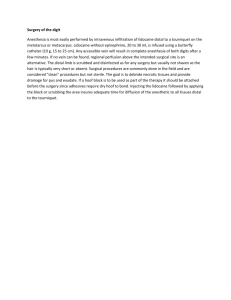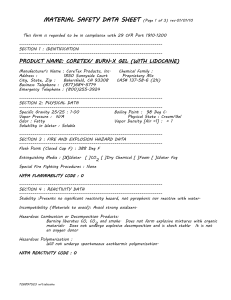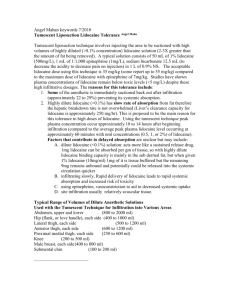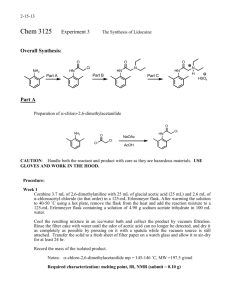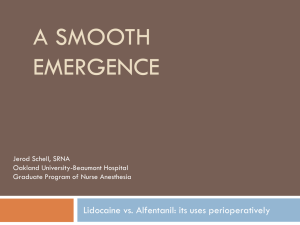Lidocaine Inhibits Blood Coagulation: Implications
advertisement
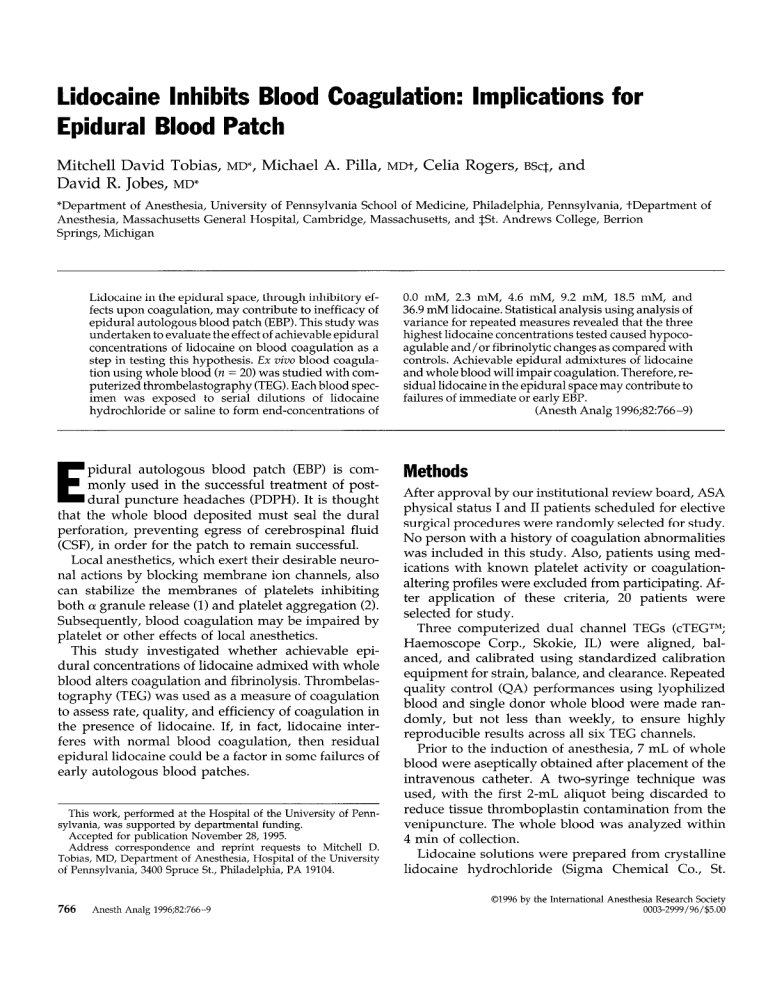
Lidocaine Inhibits Blood Coagulation: Epidural Blood Patch Mitchell David Tobias, David R. Jobes, MD* MD*, Michael A. Pilla, MDt, Implications Celia Rogers, BSCS, for and *Department of Anesthesia, University of Pennsylvania School of Medicine, Philadelphia, Pennsylvania, tDepartment of Anesthesia, MassachusettsGeneral Hospital, Cambridge, Massachusetts,and #St. Andrews College, Berrion Springs, Michigan Lidocaine in the epidural space,through inhibitory effects upon coagulation, may contribute to inefficacy of epidural autologousblood patch (EBP).This study was undertaken to evaluate the effect of achievableepidural concentrations of lidocaine on blood coagulation as a step in testing this hypothesis. Ex vivo blood coagulation using whole blood (n = 20) was studied with computerized thrombelastography (TEG).Eachblood specimen was exposed to serial dilutions of lidocaine hydrochloride or salineto form end-concentrationsof E pidural autologous blood patch (EBP) is commonly used in the successful treatment of postdural puncture headaches (PDPH). It is thought that the whole blood deposited must seal the dural perforation, preventing egress of cerebrospinal fluid (CSF), in order for the patch to remain successful. Local anesthetics, which exert their desirable neuronal actions by blocking membrane ion channels, also can stabilize the membranes of platelets inhibiting both (Ygranule release (1) and platelet aggregation (2). Subsequently, blood coagulation may be impaired by platelet or other effects of local anesthetics. This study investigated whether achievable epidural concentrations of lidocaine admixed with whole blood alters coagulation and fibrinolysis. Thrombelastography (TEG) was used as a measure of coagulation to assessrate, quality, and efficiency of coagulation in the presence of lidocaine. If, in fact, lidocaine interferes with normal blood coagulation, then residual epidural lidocaine could be a factor in some failures of early autologous blood patches. This work, performed at the Hospital of the University of Pennsylvania, was supported by departmental funding. Accepted for publication November 28, 1995. Address correspondence and reprint requests to Mitchell D. Tobias, MD, Department of Anesthesia, Hospital of the University of Pennsylvania, 3400 Spruce St., Philadelphia, PA 19104. 0.0 mM, 2.3 mM, 4.6 mM, 9.2 mM, 18.5 mM, and 36.9mM lidocaine. Statistical analysisusing analysisof variance for repeated measuresrevealed that the three highest lidocaine concentrationstestedcausedhypocoagulableand/or fibrinolytic changesascomparedwith controls. Achievable epidural admixtures of lidocaine and whole blood will impair coagulation.Therefore, residual lidocaine in the epidural spacemay contribute to failures of immediate or early EBP. (Anesth Analg 1996;82:766-9) Methods After approval by our institutional review board, ASA physical status I and II patients scheduled for elective surgical procedures were randomly selected for study. No person with a history of coagulation abnormalities was included in this study. Also, patients using medications with known platelet activity or coagulationaltering profiles were excluded from participating. After application of these criteria, 20 patients were selected for study. Three computerized dual channel TEGs (cTEGTM; Haemoscope Corp., Skokie, IL) were aligned, balanced, and calibrated using standardized calibration equipment for strain, balance, and clearance. Repeated quality control (QA) performances using lyophilized blood and single donor whole blood were made randomly, but not less than weekly, to ensure highly reproducible results across all six TEG channels. Prior to the induction of anesthesia, 7 mL of whole blood were aseptically obtained after placement of the intravenous catheter. A two-syringe technique was used, with the first 2-mL aliquot being discarded to reduce tissue thromboplastin contamination from the venipuncture. The whole blood was analyzed within 4 min of collection. Lidocaine solutions were prepared from crystalline lidocaine hydrochloride (Sigma Chemical Co., St. 01996 766 An&h Analg 1996;82:766-9 by the International Anesthesia Research Society 0003-2999/96/$5.00 ANESTH ANALG REGIONAL ANESTHESIA 1996;82:766-9 Table AND PAIN LIDOCAINE MANAGEMENT INHIBITS BLOOD TOBIAS ET AL. COAGULATION 767 1. Thrombelastographic Variables: Lidocaine-Treated Blood and Saline Control R (mm) 0.9% NS K hm) 25.23 + 8.18 10.03 ? 5.28 25.73 27.23 27.83 28.55 43.85 10.05 9.68 9.75 14.26 86.17 MA (mm) 01(7 59.48 2 11.84 43.08 f 14.06 60.55 5 11.02 45.15 43.38 42.63 34.60 12.26 Lysis 30 (%) 1.42 + 99 Lidocaine (mM) 2.3 4.6 9.2 18.5 36.9 -c k 2 -c -c 8.53 8.14 9.60 7.71 14.76* -c 4.98 t 4.57 ? 3.89 -c 7.74 + 22.56” 61.11? 11.47 56.00 ? 15.02 37.58 +- 11.96% 14.13 ? 7.62* k t 2 k t 13.93 13.52 12.43 12.89$ 8.03* 1.16 -c 1.06 0.81 1- 0.88 10.33 2 13.30t 8.35 -c 6.72* 3.50 k 6.68 All values are mean 2 SD (n = 20). NS = normal saline; R = reaction time, measured in millimeters from a chart run at 2 mm/min, is the time to first initiation of clot formation; K = coagulation time, measured in millimeters from a chart run at 2 mm/min, is the time from R to a 20-mm amplitude, and is an index to the rate of clot propagation. MA = maximum amplitude, measured in millimeters, is the maximal deflection obtained, and is an index to clot strength. a = angle, measured in degrees, is the angle from R to the tangent of the TEG curve, and is an index to the rate of fibrin plymerization; Lysis 30 = the percent decrement in the amplitude 30 min after the MA is achieved, and is an index of fibrinolysis. * n = 5; a 20.mm deflection was not reached for 15 of 20 specimens exposed to the 36.9 mM concentration of lidocaine. *P < 0.0001, tP < 0.0002, $P < 0.05: analysis of variance for repeated measures with Bonferroni post hoc analysis for lidocaine-treated blood versus saline control. Louis, MO) in 0.9% saline to create five serial endconcentrations in blood ranging from 36.9 mM (10 mg/mL) to 2.3 mM (0.625 mg/mL). The highest lidocaine concentration (36.9 mM) was chosen because it equals a theoretical large dose resulting from a 50% admixture of blood with 2% lidocaine, a mixture that might occur in the epidural space if an equivolume of EBP were performed immediately after epidural injection of lidocaine. This theoretical large dose does not incorporate any dilution or washout of lidocaine that might occur from CSF admixture. Thirty microliters of each serial lidocaine dilution was placed in five separate random TEG cups and allowed to attain 37”C, and 330 PL of whole blood from each subject was added, forming end-concentrations of lidocaine of 2.3 n-&I, 4.6 mM, 9.3 mM, 18.5 n&I, and 36.9 n-M. Physiologic saline (30 PL of 0.9% NaCl) was added to a sixth cup and used as a volumetric control (0.0 n&l). The pins of each TEG were raised and lowered five times to ensure adequate mixing of blood and additive. The morphologies and data for five TEG variables (reaction time [RI, coagulation time [Kl, maximum amplitude [MA], and percent decrement in the amplitude 30 min after MA is achieved [Lysis 301)were collected and stored on TEG software with an IBM 386 computer. R and K were recorded in millimeters on a chart running at 2 mm/min, and measure the point from when blood is placed in the TEG until the clot first forms and reaches 1 mm (R) and 20 mm (K), respectively. IX,the angle of clot formation, is indicative of the rate of clot growth and hence the rate of polymerization, was measured in degrees. MA, recorded in millimeters, is the shear modulus at maximum clot strength. Lysis 30 is an index to fibrinolytic activity. Whole blood was studied with and without lidoCaine (n = 20). Control and treatment groups were subjected to a standardized dilution (330 PL of blood and 30 PL of saline/lidocaine) to minimize volumerelated effects. Results of the test data and the quality control analyses were subjected to a one-way analysis of variance for repeated measures with Bonferroni’s post hoc test. A value for P < 0.05 was considered significant. Results Twenty ASA physical status I or II patients were included in the study. None of the subjects had measured baseline laboratory abnormalities in coagulation variables (R, K, CY,MA; prothrombin time/activated partial thromboplastin time), complete blood count, or electrolytes. QA samples run across the six channels revealed no interchannel differences. The differences in R and K for QA runs were limited to 50.5 mm (15 s), the limit of resolution of the TEG software program. Q!measurements were within 2” for all six channels for all QA analyses. MA measurements varied by no more than 2 mm for any given QA specimen. Group means, SD, and analysis of variance for repeated measures are displayed in Table 1. Maximally concentrated (36.9 mM) lidocaine-treated whole blood specimens were hypocoagulable in all measurable variables when compared to the saline-treated control. Clotting at this concentration was feeble; only five specimens at the 36.9 mM concentration achieved K, which requires a 20-mm minimum amplitude. MA differed for the two highest concentrations (18.5 and 36.9 mM). (Ydecreased significantly in value at the two highest concentrations. A significant increase in Lysis 30 of the formed clot was a consistent feature of blood specimens exposed to 9.2 mM and 18.5 mM lidocaine solutions. Figure 1 displays progressive TEGs for a typical whole blood specimen exposed to increasing concentrations of lidocaine HCl. Discussion Lidocaine significantly alters TEG-assessed whole blood coagulation and fibrinolysis. Changes were 768 REGIONAL LIDOCAINE ANESTHESIA AND INHIBITS BLOOD TEGs of Native with salinecontrol Dilution: 0.9% PAIN MANAGEMENT COAGULATION TOBIAS Whole Blood and lidocaine NS Control Lidocaine 2.3 mM Lidocaine 4.6 mM Lidocaine 92mM Lidocaine 18.5 mM Lidocaine 36.9 mM Figure 1. Representative thrombelastographs (TEGs) of a native whole blood specimen admixed with 30 PL of 0.9% saline control (NS) and serially doubling concentrations of lidocaine. The highest concentration (36.9 mM; 10 mg/mL) represents an equal volume admixture of 2% lidocaine and blood. noted in measured variables at the three highest lidoCaine concentrations tested. Commonly used epidural local anesthetics have previously demonstrated potent inhibition of normal platelet function (1,2). A new feature of the present study is the consistently observed abnormal lysis in the 9.2 mM and 18.5 mM lidocaine-treated whole blood samples (Table 1 and Figure 1). The mechanism for this abnormal fibrinolysis is unclear, but it appears to be independent of the inhibitory action on platelets. In the present study, all of the samples underwent a standard dilution of 8% (30 PL of lidocaine or saline in 330 PL of whole blood). Therefore, it is unlikely that alterations between control and treatment groups can be attributable to hemodilution. Additionally, hypercoagulability has been demonstrated by TEG after mild (15%) to moderate (25%) in viva and in vitro hemodilution (3,4). The usefulness of the TEG and the interpretation of its variables have been well presented and reviewed elsewhere (5). The TEG presents a reproducible comprehensive view of coagulation processes and yields information not available from other coagulation studies (6,7). Common coagulation tests (prothrombin time, activated partial thromboplastin time, activated clotting time) do not reliably monitor hypercoagulability, while the TEG is sensitive at detecting such changes (8). ET AL. ANESTH ANALG 1996;82:766-9 A feature of relevance to the present study is the absence of epinephrine in the lidocaine mixtures tested. Epinephrine can act as a procoagulant by potentiating adenosine diphosphate stimulation of the platelet release reaction (9). Epinephrine might therefore be expected to counteract some effect of the lidoCaine alone on clot formation. Alternatively, epinephrine markedly prolongs local anesthetic absorption half-times and may increase the unabsorbed fraction of epidural lidocaine (10). A limitation of ex vim study is an inability to know the disposition of lidocaine unaccounted for, either with or without epinephrine. The concentrations of lidocaine in this study were chosen to simulate the admixtures which might be produced in the epidural space by starting with an equal volume of 2% lidocaine and autologous blood (36.9 mM). The mass of lidocaine initially placed in the epidural space is known. Determining its concentration as a function of time is, however, not easily accomplished. Since the concentration of lidocaine will be dependent on the relative uptake of the local anesthetic versus its diluent, counter intuitively, lidocaine could become more concentrated than it was on initial injection. The initial concentration of lidocaine attained in an EBP also may be higher than 36.9 mM, if lower ratios of blood to lidocaine are realized. Alternatively, CSF from the wet tap may dilute or washout epidural lidocaine. The inability to accurately know the epidural conditions is a limitation to the interpretation of this ex rho study. Another important limitation of this study is the inability to determine how well blood and lidocaine may mix in the epidural space. Mixing in the TEG cuvette is rather complete, since the small volume is agitated both by pipetting and by raising and lowering the TEG column. The pharmacokinetics of lidocaine administered to the epidural space has been well studied (11). Four hours after epidural injection, approximately 20% of the lidocaine remains unaccounted for in plasma. It is impossible that this mass of local anesthetic is fully available for clot inhibition, but the amount and concentration available is not known. At four hours the maximum mass of lidocaine could correspond to the 9.2 mM dilution of our study. Clot lysis was prominently seen at this concentration. PDPH is a complication that can be debilitating in its severity. PDPH results from the leakage of CSF through the hole in the dura mater. The fluid flows from the subarachnoid space to the subatmospheric pressures of the epidural space. EBP, in the treatment of PDPH, probably is effective by two mechanisms. A dramatic, often immediate success for EBP occurs by a mass effect which can triple sagging CSF pressures (12) by extrinsically indenting the dura. This is also the proposed mechanism for the transient relief from PDPH after epidural saline administration (13). It has been shown that almost one third of initially effective ANESTH ANALG 1996;82:766-9 REGIONAL EBPs recur after a variable period of relief (14). A desirable prolonged effect likely requires a physical sealing of the dural hole and a stemming of further CSF egress. This lasting effect requires the administered autologous blood to coagulate and adhere to, or plug, the dural perforation (15). Such adherence and coagulation may be impaired by lidocaine inhibition of clot formation or by lysis of the formed clot. The immediate administration of procaine has been advocated if CSF is encountered while performing EBP (16) in order to rule out subarachnoid needle placement. Preliminary data suggest that procaine, chloroprocaine with EDTA, and bupivicaine will also produce hypocoagulable changes similar to those of lidocaine. The results of this study may support simple maneuvers prior to immediate or early EBP. If significant concentrations of lidocaine are present in the epidural space, as evidenced by its immediate or recent injection or by the continued presence of a block, we advocate: 1) dilution of the lidocaine with an epidural saline infusion (an effective temporary treatment for PDPH); or 2) waiting for dissipation of the block (a prudent delay prior to EBP, in any event). Therapeutic or prophylactic EBP is not always a benign procedure (17-19) and should be given its highest probability of being effective on first administration. References 1. Feinstein MB, Fiekers J, Fraser C. An analysis of the mechanism of local anesthetic inhibition of platelet aggregation and secretion. J Pharmacol Exp Ther 1976;197:215-28. 2. Borg T, Modig J. Potential anti-thrombotic effects of local anaesthetics due to their inhibition of platelet aggregation. Acta Anaesthesiol Stand 1985;29:739-42. 3. Tuman KJ, Spiess BD, McCarthy RJ, Ivankovitch AD. Effects of progressive blood loss on coagulation as measured by thromboerastography. Anesth Analg-1987;66:856-86 . 4. Tobias MD, Pilla MA, Rogers C. Effects of seauential hemodilution upon TEG assessed”blood coagulation [abstract]. Anesth Analg 1995;80:5503. ANESTHESIA AND PAIN LIDOCAINE MANAGEMENT INHIBITS BLOOD TOBIAS ET AL. COAGULATION 769 5. Mallett SV, Cox DJA. Thromboelastography. Br J Anaesth 1992; 69:307-313. 6. Hartert H, Schaeder JA. The physical and biological constants of thromboelastography. Biorheology 1962;1:31-9. 7. Zuckerman L, Cohen E, Vagher JP, et al. Comparison of thromboelastography with common coagulation tests. Throm Haemost 1981;46:752-6. 8. Howland WS, Schweizer 0, Gould I’. A comparison of intraoperative measurements of coagulation. Anesth Analg 1974;53: 657-63. 9. Weiss HJ. Platelet mechanisms. In: Weiss HJ, ed. Platelets. Pathophysiology and antiplatelet drug therapy. New York: Alan R. Liss Inc, 1982:1-26. 10. Burm AGL, Vermeulen NPE, van Kleef JW, et al. Pharmacokinetics of lignocaine and bupivicaine in surgical patients following epidural administration. Simultaneous investigation of absorption and dispisition kinetics using stable isotopes. Clin Pharmacokinet 1987;13:191-203. 11. Mather LE, Tucker GT, Murphy TM, et al. The effects of adding adrenaline to etidocaine and lignocaine in extradural anaesthesia. II. Pharmacokinetics. Br J Anaesth 1976;48:989-93. 12. Coombs DW, Hooper D. Subarachnoid pressure with epidural blood “patch.” Reg Anesth 1979;4:3-5. 13. Usubiaga JE, Usubiaga LE, Brea LM, et al. Effect of saline injection on epidural and subarachnoid space pressures and relation to postspinal anesthesia headache. Anesth Analg 1967; 46293-6. 14. Taivainen T, Pitkanen M, Tuominen M, et al. Efficacy of epidural blood patch for postdural puncture headache. Acta Anaesthesiol Stand 1993;37:702-5. 15. Rosenberg PH, Heavener JE. In vitro study of the effect of epidural blood patch on leakage through a dural puncture. Anesth Analg 1985;64:501-4. 16. Cucchiara RF, Wedel DJ. Finding cerebrospinal fluid during ;$lual blood patch: how to proceed. Anesth Analg 1984;63: 17. Seeberger MD, Urwyler A. Lumbovertebral syndrome after extradural blood patch. Br J Anaesth 1992;69:414-6. 18. Reynolds AF, Hameroff SR, Blitt CD, et al. Spinal subdural hematoma: a complication of a novel epidural blood patch technique. Anesth Analg 1980;59:702-3. 19. Tarkkila PJ, Miralles JA, Palomaki EA. The subjective complications and efficiency of the epidural blood patch in the treatment of postdural puncture headache. Reg Anesth 1989;14: 247-50.
